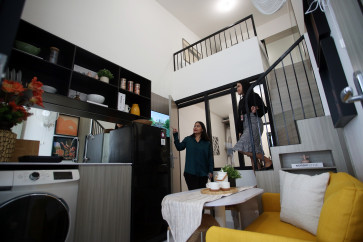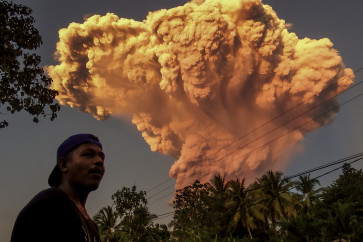Popular Reads
Top Results
Can't find what you're looking for?
View all search resultsPopular Reads
Top Results
Can't find what you're looking for?
View all search resultsCoastal wall collapse raises safety concerns
Breached: Rubble marks the spot where a section of the National Capital Integrated Coastal Development’s seawall once stood on the eastern side of Nizam Rachman Port in Penjaringan, North Jakarta
Change text size
Gift Premium Articles
to Anyone

B
reached: Rubble marks the spot where a section of the National Capital Integrated Coastal Development’s seawall once stood on the eastern side of Nizam Rachman Port in Penjaringan, North Jakarta. The seawall collapsed on Tuesday afternoon.(JP/P.J.Leo)
A 170-meter section of the coastal wall built as part of the National Capital Integrated Coastal Development (NCICD) in North Jakarta, collapsed earlier this week, prompting the government to launch an investigation amid concerns about the safety of coastal areas from future flooding.
Videos circulating on social media this week showed the concrete coastal wall, built by the Public Works and Housing Ministry, slowly collapsing at the Nizam Rachman Port in Penjaringan.
As a result, seawater has now inundated areas behind a dike that had been covered with soil for the embankment project, which is the first phase, called phase A, of the NCICD program. The first phase involves the strengthening of the existing coastal wall and the construction of a new coastal wall, totaling 120 kilometers along the coast of Jakarta, Bekasi in West Java and Tangerang, Banten. Since 2014, the central government and Jakarta administration have only built some 17 km of the proposed 120 km.
According to local residents, the incident occurred at around 4:30 p.m. on Dec. 3.
“I was sitting here [at a security post facing the shore] when I heard people screaming. We all went out to see what was happening,” ship technician Asri Mulyono told The Jakarta Post on Thursday.
The 47-year-old recalled how, when the incident occurred, he was afraid the ground where he stood would also give way, given that the entire port area is on reclaimed land. He said it was fortunate that the incident took place on a weekday rather than on the weekend when many people gather on the dike to fish.
Echoing Asri, food seller Dwi Utami Handayani said she was at her warung (food stall) when the dike collapsed and people flocked to the scene. “It was scary. I was scared there would be more flooding because this place is really low lying,” she said.
Another witness Alex, a worker at a transit factory across from the collapsed dike, said the site had been closed to the public since Wednesday morning. Some officers guarding the area declined to comment when the Post approached them.
The coastal wall is separate from the controversial giant seawall. The construction of the giant seawall, will be built offshore in Jakarta Bay, is called phase B, and there is no definite schedule as to when construction will begin.
In September, the Post carried an in-depth report about the construction of the coastal wall and interviewed residents who said they were happy with the stronger and higher wall because it protected them from flooding from the sea.
The head of the Public Works and Housing Ministry’s Ciliwung-Cisadane Flood Control Office (BBWSCC), Bambang Hidayah, said it was yet to determine the cause of the incident. “We’re still investigating it. We need at least three or four days, or maybe a week,” he told the Post on Thursday.
Many experts have warned that Jakarta is sinking. However, each area has a different rate of sinking with some parts sinking by up to 18 centimeters a year, while other have only sunk by 5 centimeters
The BBWSCC’s NCICD commitment maker Ilham Firmansyah said that land subsidence where the incident took place occurred at a rather fast pace, without being specific about the rate.
After the investigation, expected to be complete within this week, Ilham said the BBWSCC would hold a meeting on Sunday to decide what measures to take and how to conduct them, particularly the repairs of the damaged embankment.
“We are still not certain about the cause [of the collapse]. It might be wave pressure or lateral earth pressure. We’re still monitoring the other spun piles for any possible movement,” he said.
“After Monday’s meeting, we can also decide whether to revise the design made back in 2015,” he told the Post over the phone.
Ilham, however, said he was optimistic and he gave an assurance that the ministry would do whatever it took to ensure that the existing embankment and those to be built in the future, would be safe and secure.
Bandung Institute of Technology (ITB) geologist Muslim Muin suspected there was a fault in the design that made the dike prone to shifting. “The ministry should be more open [about the collapse]. I doubt that they conducted extensive research prior to the construction,” he said.
“Have they made sure that the ground is firm enough? Is it solid enough to support the dike construction given its heavy weight? They can’t simply apply the same embankment design for all areas,” he added.
Lambok Hutasoit, a professor on hydrogeology at ITB, said he did not want to comment on the particular case but as a geologist, in general, there was a risk when building on subsiding land. “Especially if the rate of subsidence between one point and the other is not the same. If one point is deeper, it’s more difficult, the structure could crack,” he said.
Even though the forecast for sinking Jakarta is grim, the Jakarta administration and the central government do not have a program to stop it. Experts, including Dutch scientists, have said that to stop the sinking, Jakarta has to stop groundwater extraction.
The government has decided to focus on strengthening coastal defenses and building the giant sea wall and although Jakarta Governor Anies Baswedan inspected buildings this year that still extracted groundwater for their daily needs, reprimanding them, there has been no serious follow up since then.
In mid-2019, the ministry signed an agreement with the Korea International Cooperation Agency and the Netherlands’ Infrastructure and Water Management Ministry for the construction of NCICD phase B. (ydp)









